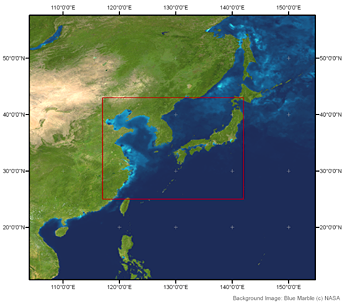

Yellow Sea
26. April 2005,
orbit: 16490

C2R RGB
Channels: 6, 5, 2

Depth where 90% of the light is absorbed at wavelength where this value is maximal

Yellow substance absorbtion at 442 nm
Click on the small images above to get the full resolution image (appr. 5÷6MB)
|
Site11: China, Korea, Japan
East China Sea, Yellow Sea, Sea of Japan
Standard products |
Experimental products |
Responsible partner |
|
- Formazin Nepholometric Units
- Primary Productivity or Potential Primary Productivity
- Concentrations of some taxonomic of functional groups such as Coccolithophorides, Cyanobacteria etc.
|
|
 The large marine China, Korea, Japan region is impacted by se-vere pressures from the highly populated coastal strips. Economic interests are sig-nificant and environmental problems range from sedimentation off the mouths of major rivers (Yangtse/Chang Jiang), harmful algae blooms (e.g. Pearl Estuary, Zhoushan area in East China Sea, and Guangdong province coastal strip, eastern Geoje Island in Korea, etc.) and eutrophication in many river estu-aries and plumes. The waters around China, Korea and Japan include the most extreme optical conditions. The large marine China, Korea, Japan region is impacted by se-vere pressures from the highly populated coastal strips. Economic interests are sig-nificant and environmental problems range from sedimentation off the mouths of major rivers (Yangtse/Chang Jiang), harmful algae blooms (e.g. Pearl Estuary, Zhoushan area in East China Sea, and Guangdong province coastal strip, eastern Geoje Island in Korea, etc.) and eutrophication in many river estu-aries and plumes. The waters around China, Korea and Japan include the most extreme optical conditions.
Along the shallow coasts of the Yellow and Bohai Sea suspended matter concentrations occur in the range of more than 1 kg/m3. In this concentration range the reflectance is higher than land and in the blue and green spectral bands does not show any increase with increasing con-centrations. Thus, in order t o resolve the concentrations in the high range it is necessary to use the red and NIR spectral bands, which in turn, requires adapted atmospheric correction procedure. A further issue, which require special algorithms, are frequently occurring Red Tides and floating algae (s. problems during Olympic Games 2008).
Local interest in the use of ocean colour remote sensing is clear from the large number of SeaDAS users. Korean Space Agency (KSAT) and KORDI have planned the first geostationary ocean colour sensor, GOCI, and federated scientists from the whole region and from Europe and the US to exploit the planned data.
|

